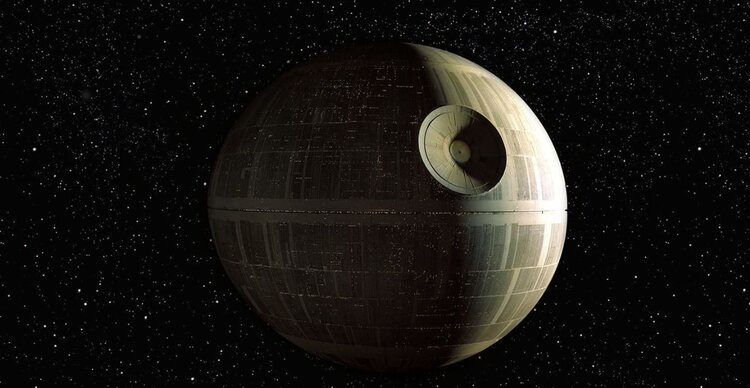The Death Star, of course, is one of the biggest weapons the Empire could ever be proud of. They spent nearly two decades building the first one — only for it to get blown up by the Rebels in just a few days. Then, not learning their lesson, the Empire went and built a second one… which also ended the same way.
So the real question is: was the Death Star actually a good investment for the Empire?
Thrawn Believed It Was a Waste
So for me, I’m not exactly a military expert or anything like that — but we can look at this question from someone who actually is: Grand Admiral Thrawn, one of the greatest strategists in the Star Wars universe.
And for Thrawn, the Death Star was absolutely a waste of resources.
As mentioned in Thrawn (the 2016 canon novel by Timothy Zahn), Thrawn directly told Emperor Palpatine that building such a massive superweapon wasn’t a wise decision. He believed that instead of pouring everything into one enormous battle station, the Empire should focus on developing more practical and flexible forces — like his own TIE Defender Program.
In the book, we see Thrawn questioning Palpatine about the secret Death Star project. The Emperor immediately challenges him, asking how he even learned of its existence.
Thrawn calmly replies:
“I learned the name from unguarded dispatches. I deduced the size and power from resource allocations. I now wish to learn from you its purpose.”

Palpatine assumes Thrawn’s concern is personal — that he fears the Emperor might one day use the Death Star against the Chiss Ascendancy, Thrawn’s own people. The Emperor even assures him that once the Rebels are defeated, the Death Star could help destroy Thrawn’s enemies as well.
But Thrawn clarifies that his fear isn’t about personal danger — it’s about wasting resources. He tells the Emperor:
“I would certainly not wish to see my aid to you and your Empire subverted into conquest and destruction. But I would also warn against diverting too many of the Empire’s resources from a flexible navy of capital ships and starfighters to massive projects that can bring the Imperial presence to only one system at a time.”

That’s Thrawn’s whole point — the Death Star might be powerful, but it can only be in one place at once. A fleet of ships could project the Empire’s control everywhere at once, while the Death Star could only destroy, not hold. To him, it wasn’t strategy — it was arrogance disguised as strength.
Even Darth Vader Supported Thrawn’s TIE Defender Project Than Stardust Project
It turns out Thrawn wasn’t the only one who questioned putting all the Empire’s resources into the Death Star. Even Darth Vader himself — the Emperor’s enforcer — came to see the potential of Thrawn’s TIE Defender project.
During their joint mission against the Grysk Hegemony, as told in Star Wars: Thrawn – Alliances, Vader got to witness the Defender in action alongside Thrawn and the Seventh Fleet. After the mission, he admitted just how impressive the new fighter was. In his own words:
“The Defender is an excellent ship. I will speak to the Emperor on behalf of the project. But it needs to be faster, and more heavily armed. The controls, too, should also be made simpler.”
That line says it all — even Vader, who normally trusted in brute power, saw how effective Thrawn’s design was. He wasn’t just impressed by the ship’s firepower but recognized how it could actually strengthen the Empire’s navy across the galaxy.
Vader told Thrawn he would personally speak to the Emperor to support the project, while Thrawn promised to send his recommendations back to the Lothal production facility once they returned to Coruscant.
In the end, both of them understood the truth that Palpatine didn’t want to hear: the Empire didn’t need one massive superweapon — it needed smarter, faster, and stronger fleets that could adapt anywhere in the galaxy.
Conclusion
If we’re talking purely from a military point of view, the Death Star was never a good investment. It was a symbol of fear, not strategy. Thrawn and even Vader understood that real power comes from mobility and precision, not from one oversized superweapon. In the end, the Empire didn’t fall because it was weak — it fell because it refused to listen to its smartest minds.

